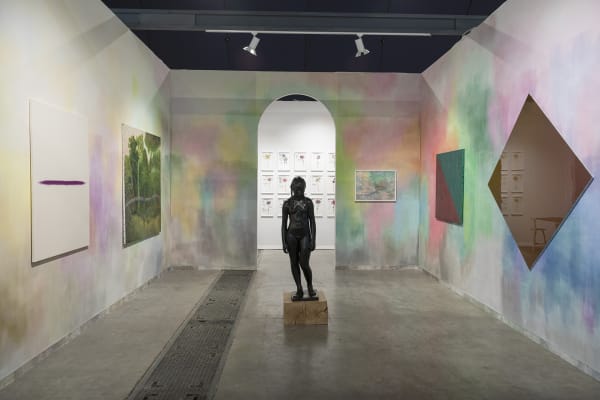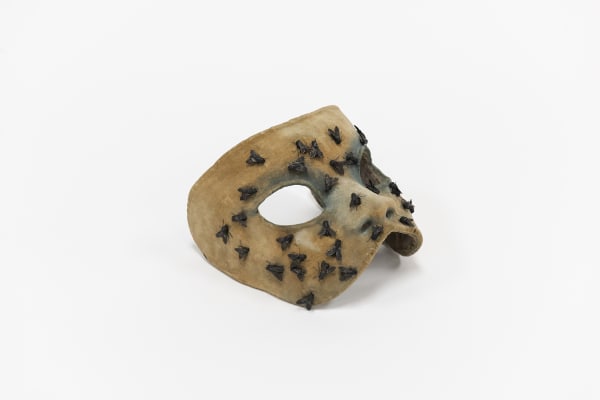« IL Y A L'ART OFFICIEL, ET IL Y A L’ART » (1935)
René Iché est considéré comme l’un des plus remarquables représentants de la sculpture moderne française, puis après-guerre du mouvement de la Figuration européenne aux côtés d’Henri Moore, Marino Marini, Alberto Giacometti et Francis Bacon.
Figure même de l’artiste engagé, ses recherches esthétiques et techniques ont été menées de front avec une réflexion plus générale sur la place de l’artiste dans la société et dans l’histoire. Il a dveloppé une œuvre érudite, à plusieurs niveaux de lecture, interrogeant ses expériences intimes pour concevoir une œuvre contemporaine de portée universelle.
Pendant la première guerre mondiale, Iché fréquente Guillaume Apollinaire et l’avant- garde à Paris. Démobilisé, il écrit pour la presse et le théâtre, entre dans l’administration avant de tout abandonner pour devenir sculpteur.
Il est proche du groupe de la Section d’or, et d’Auguste Perret, rencontré chez Bourdelle. Il étudie le béton, la céramique, la fonte et l’architecture.
La Guerre et Homme et enfant de 1925, sont les seules œuvres qui ont survécu alors que Forfaiture, jugée « indécente » en 1923 par le Salon des Indépendants reste de nos jours introuvable. Ces œuvres partagent un aspect lisse, tout en rondeur et en sensualité qui adoucit le sujet comme dans le Monument aux morts de 14-18, à Ouveillan, ouvertement pacifiste et aujourd’hui considéré comme l’un des plus beaux de France.
Son Etude de Lutteurs, groupe primitif, en granit, sculpté au tournevis, déconcerte et choque la critique. Un homme nu, dédoublé, affronte ses démons intérieurs. Iché garde l’espoir que l’homme moderne pourra sublimer ses égoïsmes et deux décades plus tard, quand il aura rejoint la Résistance, Iché revisitera ce sujet de manière quasi obsessionnelle avec Lutteurs à terre, Lutteurs à mi-corps, Fragment de Lutteurs...
En 1930 le marchand Léopold Zborowski sort Iché de la misère en lui achetant l’ensemble de sa production. Il organise une première exposition personnelle et les œuvres d’Iché entrent dans les collections des musées européens.
Depuis plusieurs années, Iché soutient les surréalistes dont il partage les approches, artistiques et thématiques, le goût du hasard, de la provocation et de l’humour noir. Ses mystérieuses Inconnue de la Seine et ses masques d'André Breton et de Paul Eluard, yeux clos, immergés dans une léthargie propice à la rêverie et à l’écriture automatique préfigurent ou accompagnent leurs recherches. L’année suivante, comme Alberto Giacometti, il s’investit dans l’art de la médaille dont il repense le choix des sujets et les techniques. ll revient au nu et décline des fragments érotiques de : Jeune Captive, Jeune Homme ou Contrefleur, en plâtre, en bronze et en marbre. Ses portraits psychologiques alternent avec des œuvres-manifestes: Melpomène 36 pour l’intervention en Espagne ou la sublime et provocante Guernica, qu’il modèle le soir même de l’attaque, c’est à dire, bien avant Picasso. Ce squelette d’une fillette, toujours debout mais martyrisée dans sa chair est tout droit sorti d’un cauchemar lovecraftien. Guernica ne sera exposée qu’une seule fois, en septembre 1939.
Germaine Tillon racontait que dans un même élan, pendant l’Occupation, Iché improvisa sous ses yeux la Déchirée à partir d’un nu de 1937. Elle devient le symbole de la Liberté, aveugle et implorante. Une fonte, produite par Iché parvient au Général De Gaulle à Londres grâce à l’aide de Lucie Aubrac et de Jean Cavaillès.
Après la Libération, Iché inscrit ses Otages ou les Lutteurs dans un espace ouvert où la sculpture monumentale s’associe à l’architecture. Dans le prolongement de ses prises de position de l’entre-deux-guerre, Iché fonde et organise de nouvelles instances professionnelles (Maison des artistes, Syndicat des sculpteurs, ADAGP) et obtient l’établissement de la loi du 1%. L’objectif est la reconnaissance professionnelle des artistes plasticiens via des circuits indépendants et l’ouverture de la commande publique aux « non académiques ».
Il décède brutalement le 23 décembre 1954 à Paris, sans avoir pu exécuter le Monument à Apollinaire, finalement réalisé par Pablo Picasso, et le Mémorial aux Martyrs d’Auschwitz qui ne fut jamais réalisé mais pour lequel il avait imaginé un espace collectif réunissant des artistes de nations touchées par la déportation.
Certains projets d’Iché ont été réalisés après sa mort par de jeunes artistes comme l’Enclos du Souvenir au Mont-Valérien ou encore l’installation de sculptures dans les Jardins du Palais-Royal.
Les fontes originales de René Iché sont aujourd’hui produites sous la surveillance de sa petite fille, héritière des droits et auteur du catalogue raisonné. Elle veille à l’intégrité de l’oeuvre et au maintien des directives fixées par René Iché.
Bernard Blistène : La découverte de certaines de ses œuvres parmi les plus célèbres dont, bien évidemment, l'extraordinaire Guernica, mais aussi l'intérêt qu'a éveillé en moi sa biographie. Je sais qu'aujourd'hui l'idée d'engagement est galvaudée mais il me semble que le chemin d'Iché, ses rencontres, sont d'une importance capitale pour saisir la singularité de son œuvre.
De par ses dates, Iché reste assimilé à la sculpture de l'entre-deux-guerres et à une forme de classicisme qui fait d'ailleurs partie de certains aspects de son travail. Mais en même temps, son parcours est profondément différent pour qu'on éprouve le désir d'y aller voir de près.
Voyez au fil des années 1930, tant par rapport aux républicains espagnols que, bien sûr, par rapport à la Seconde Guerre mondiale et au rôle qu'il a eu dans les Forces françaises libres, combien son œuvre se métamorphose. Mais voyez aussi ce lien si fort avec les poètes : ses amitiés de jeunesse avec Joë Bousquet, sa proximité avec Guillaume Apollinaire et Pierre Reverdy ou Max Jacob, ses rencontres avec ceux qui deviendront les surréalistes dont il fera les célèbres masques. Iché est certes un homme engagé mais ses études d'histoire de l'art, ses fréquentations des esprits les plus aiguisés du temps font que son œuvre est en constante métamorphose. Et c'est dans cette perspective que j'attends de ces expositions qu'elles contribuent à ébranler une histoire de l'art par trop linéaire.
-

ART PARIS
30 Mars - 2 Avril 2023ADAM BOGEY | MATHILDE DENIZE | QUENTIN DEROUET | JOSÉ GAMARRA | RENÉ ICHÉ | JACQUELINE LAMBA | JACQUES PRÉVERT | ROBERT MALAVAL | OLIVIER...Lire plus -

ART PARIS
9 - 12 Septembre 2021ADAM BOGEY | RENÉ ICHÉ | FRANÇOIS RISTORILire plus -

TEFAF MAASTRICHT ONLINE
8 - 13 Septembre 2021LEONOR FINI | JACQUES PRÉVERT | RENÉ ICHÉLire plus




